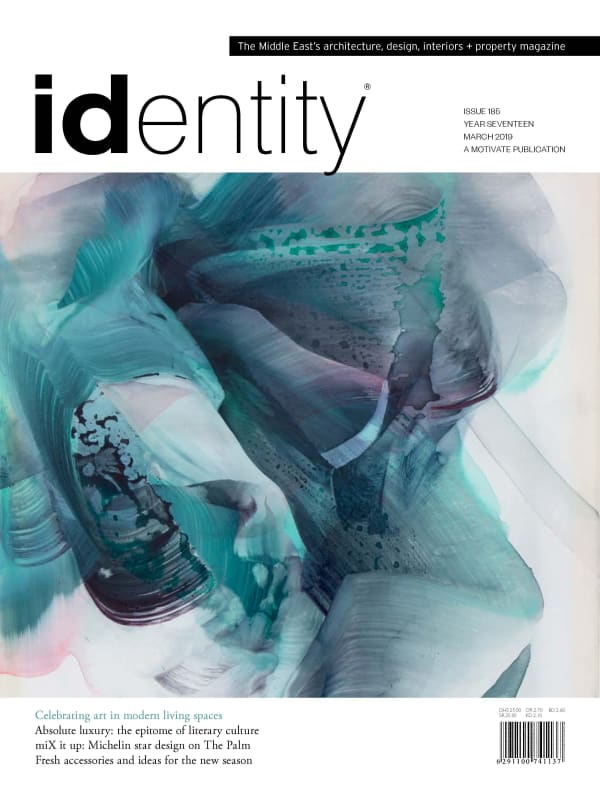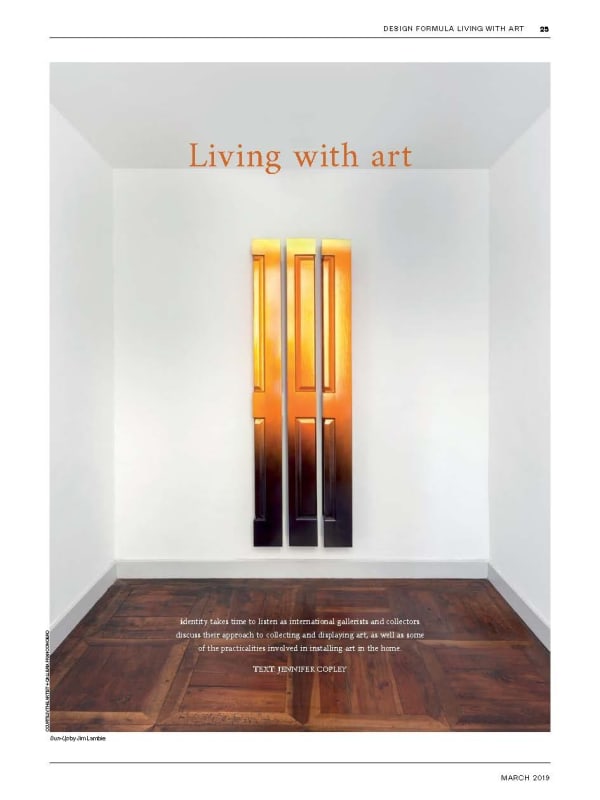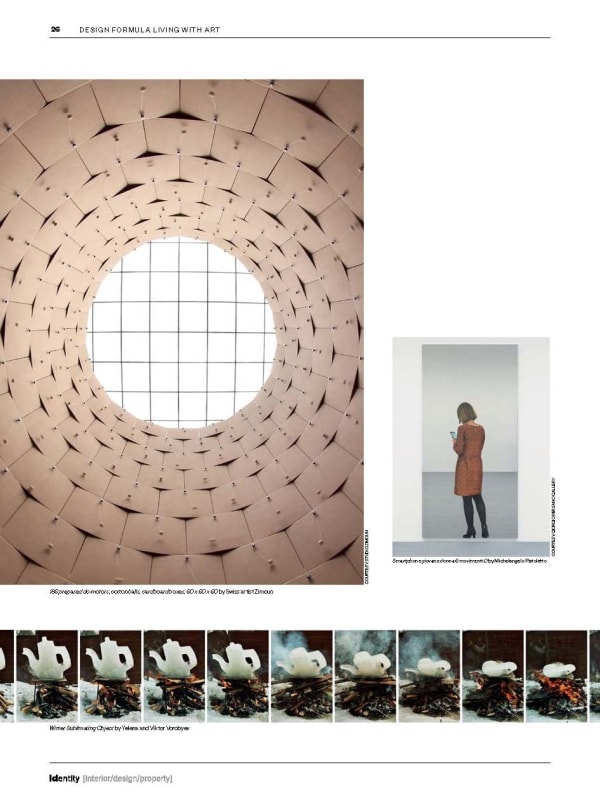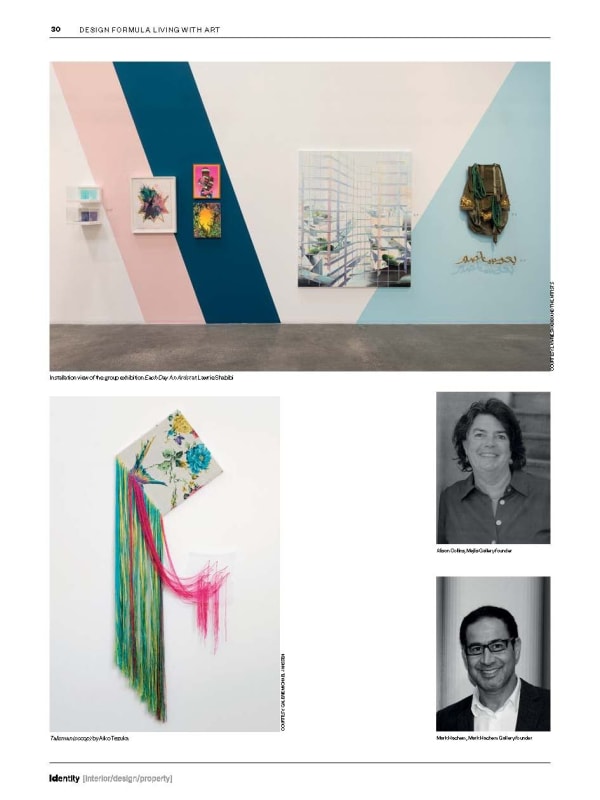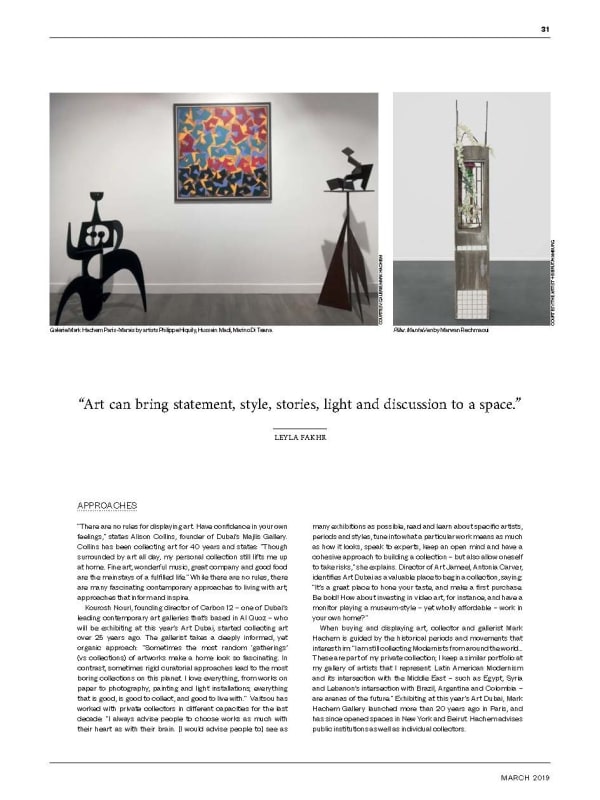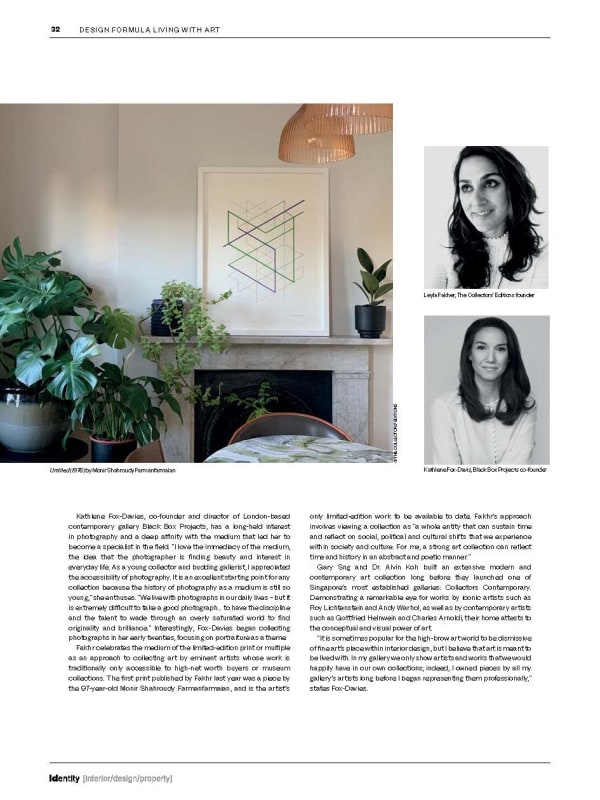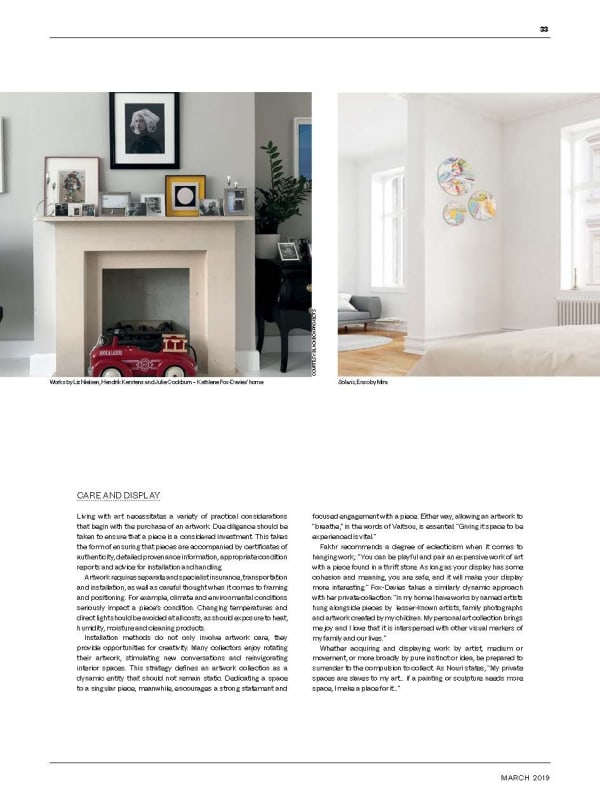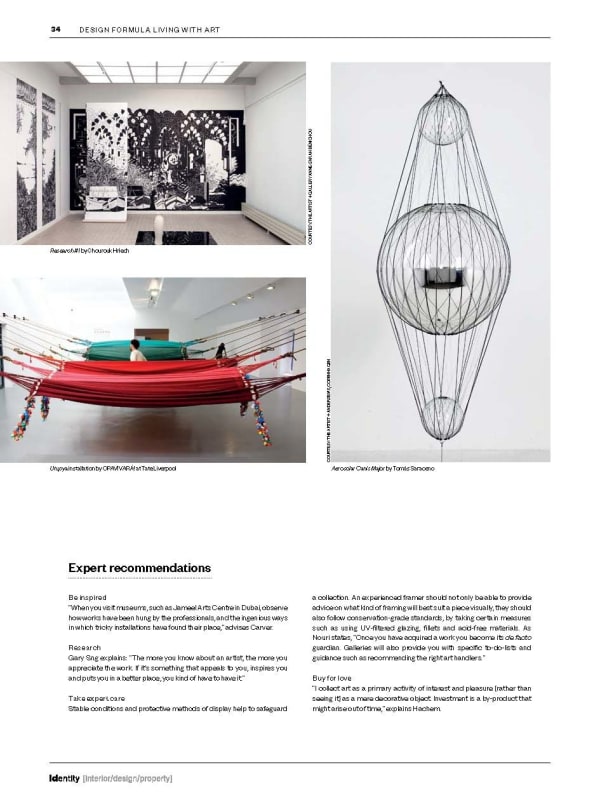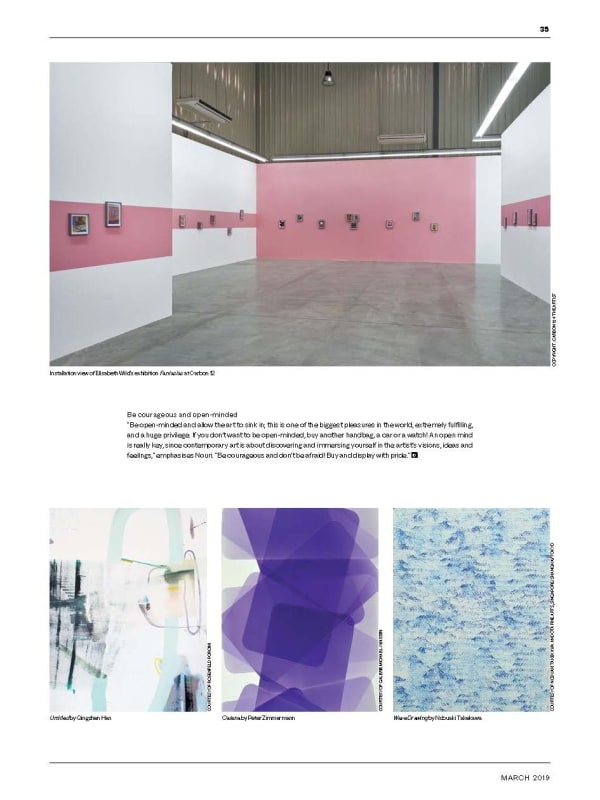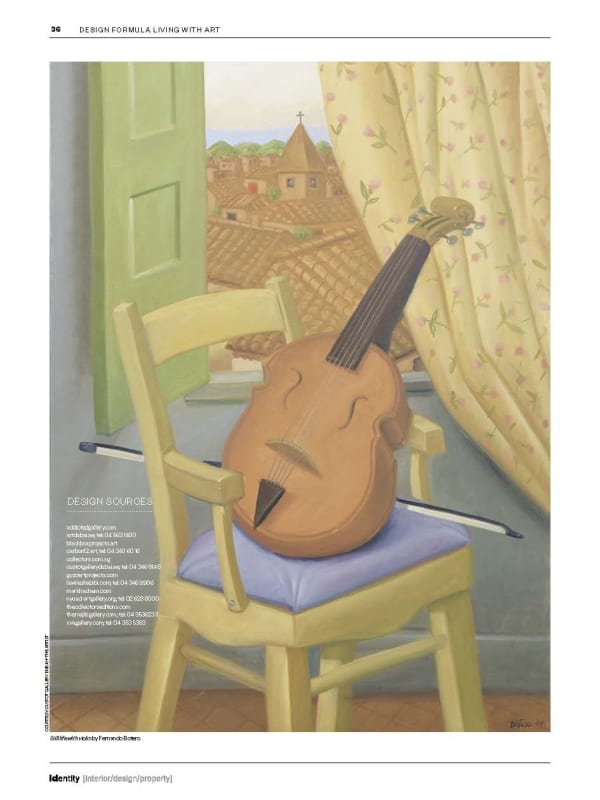LIVING WITH ART
Identity takes time to listen as international gallerists and collectors discuss their approach to collecting and displaying art, as well as some of the practicalities involved with installing art in the home. Black Box Projects Co-Founder and Director, Kathlene Fox-Davies, speaks with Jennifer Copley about collecting art and making an art collection personal.
Written by Jennifer Copley
A PERSONAL STATEMENT
"Art can bring statement, style, stories, light and discussion to a space. When you ask people about their earliest memories of their home, they often will remember prints or paintings that their parents owned. The art you bring into your home shapes your life and your identity. A great collection of art really will make your personal environment stand out from any other space and give it a special atmosphere that is hard to create through any other means," explains Leyla Fakhr, founder of The Collectors' Editions. Fakhr is well - versed in the language of art acquisition and display, having worked as a curator at Tate London before launching a new online platform last year. The Collectors' Editions specialises in work by artists from the Middle East and North Africa, and this focus reflects Fakhr's own interests: "My personal background relates to artists that have experienced notions of diaspora, as I am Iranian but grew up in Germany, England and America. Every piece I acquire reflects a specific time and even place in my life," she explains. "Ultimately every art collection should arise from a personal place and that is what can make a collection intriguing."
Fakhr's comments shed light on the highly subjective nature of art collecting and display - an endeavour that can be both personally meaningful and fascinatingly idiosyncratic. As Chloe Vaitsou, newly appointed International Director of Art Dubai, succinctly states: "Art in a private residence should be about its owner's philosophy of life."
Living with art can take myriad forms. Art can be integrated into the very fabric of a space and it can fill a home in the form of a timeline of objects. Like artefacts of memory and experience, art illuminates the passions and preoccupations of those who possess it. Blair and Elena Assini-Thomson, founders of Addicted Art Gallery in Singapore, have amassed a collection of over 250 artworks: "These pieces are a reflection and a reminder of where we have been, and of the fond memories made along the way," they say. Many collectors describe living with art as transformative. Wanja Kimani, artist and co-founder of Guzo Art Projects, an artist-led initiative established in Addis Ababa, explains: "Art can transform a living space and breathe life into it. It can be a talking point and can reveal something about us to ourselves and others." Kimani will be exhibiting in Art Dubai's inaugural Bawwaba, the fair's new gallery section.
APPROACHES
"There are no rules for displaying art. Have confidence in your own feelings," states Alison Collins, founder of Dubai's Majlis Gallery. Collins has been collecting art for 40 years and states: "Though surrounded by art all day, my personal collection still lifts me up at home. Fine art, wonderful music, great company and good food are the mainstays of a fulfilled life." While there are no rules, there are many fascinating contemporary approaches to living with art; approaches that inform and inspire.
Kourosh Nouri, founding director of Carbon 12-one of Dubai's leading contemporary art galleries that's based in AlQuoz-who will be exhibiting at this year's Art Dubai, started collecting art over 25 years ago. The gallerist takes a deeply informed, yet organic approach: "Sometimes the most random 'gatherings' (vs collections) of artworks make a home look so fascinating. In contrast, sometimes rigid curatorial approaches lead to the most boring collections on this planet. I love everything, from works on paper to photography, painting and light installations; everything that is good, is good to collect, and good to live with." Vaitsou has worked with private collectors in different capacities for the last decade. "I always advise people to choose works as much with their heart as with their brain. [I would advise people to] see as many exhibitions as possible, read and learn about specific artists, periods and styles, tune into what a particular work means as much as how it looks, speak to experts, keep an open mind and have a cohesive approach to building a collection-but also allow oneself to take risks," she explains. Director of Art Jameel, Antonia Carver, identifies Art Dubai as a valuable place to begin a collection, saying: "It's a great place to hone your taste, and make a first purchase. Be bold! How about investing in video art, for instance, and have a monitor playing a museum-style-yet wholly affordable-work in your own home?"
When buying and displaying art, collector and gallerist Mark Hachem is guided by the historical periods and movements that interest him: "I am still collecting Modernists from around the world… These are part of my private collection; I keep a similar portfolio at my gallery of artists that I represent. Latin American Modernism and its intersection with the Middle East-such as Egypt, Syria and Lebanon's intersection with Brazil, Argentina and Colombia- are arenas of the future." Exhibiting at this year's Art Dubai, Mark Hachem Gallery launched more than 20 years ago in Paris, and has since opened spaces in New York and Beirut. Hachem advises public institutions as well as individual collectors.
Kathlene Fox-Davies, co-founder and director of London-based contemporary gallery Black Box Projects, has a long-held interest in photography and a deep affinity with the medium that led her to become a specialist in the field. "I love the immediacy of the medium, the idea that the photographer is finding beauty and interest in everyday life. As a young collector and budding gallerist, I appreciated the accessibility of photography. It is an excellent starting point for any collection because the history of photography as a medium is still so young," she enthuses. "We live with photographs in our daily lives-but it is extremely difficult to take a good photograph…to have the discipline and the talent to wade through an overly saturated world to find originality and brilliance." Interestingly, Fox-Davies began collecting photographs in her early twenties, focusing on portraiture as a theme.
Fakhr celebrates the medium of the limited-edition print or multiple as an approach to collecting art by eminent artists whose work is traditionally only accessible to high-net worth buyers or museum collections. The first print published by Fakhr last year was a piece by the 97-year-old Monir Shahroudy Farmanfarmaian, and is the artist's only limited-edition work to be available to date. Fakhr's approach involves viewing a collection as "a whole entity that can sustain time and reflect on social, political and cultural shifts that we experience within society and culture. For me, a strong art collection can reflect time and history in an abstract and poetic manner."
Gary Sng and Dr. Alvin Koh built an extensive modern and contemporary art collection long before they launched one of Singapore's most established galleries: CollectorsContemporary. Demonstrating a remarkable eye for works by iconic artists such as Roy Lichtenstein and Andy Warhol, as well as by contemporary artists such as Gottfried Helnwein and Charles Arnoldi, their home attests to the conceptual and visual power of art.
"It is sometimes popular for the high-brow art world to be dismissive of fine art's place within interior design, but I believe that art is meant to be lived with. In my gallery we only show artists and works that we would happily have in our own collections; indeed, I owned pieces by all my gallery's artists long before I began representing them professionally," states Fox-Davies.
CARE AND DISPLAY
Living with art necessitates a variety of practical considerations that begin with the purchase of an artwork. Due diligence should be taken to ensure that a piece is a considered investment. This takes the form of ensuring that pieces are accompanied by certificates of authenticity, detailed provenance information, appropriate condition reports and advice for installation and handling.
Artwork requires separate and specialist insurance, transportation and installation, as well as careful thought when it comes to framing and positioning. For example, climate and environmental conditions seriously impact a piece's condition. Changing temperatures and direct light should be avoided at all costs, as should exposure to heat, humidity, moisture and cleaning products.
Installation methods do not only involve artwork care, they provide opportunities for creativity. Many collectors enjoy rotating their artwork, stimulating new conversations and reinvigorating interior spaces. This strategy defines an artwork collection as a dynamic entity that should not remain static. Dedicating a space to a singular piece, meanwhile, encourages a strong statement and focused engagement with a piece. Either way, allowing an artwork to "breathe," in the words of Vaitsou, is essential: "Giving it space to be experienced is vital."
Fakhr recommends a degree of eclecticism when it comes to hanging work: "You can be playful and pair an expensive work of art with a piece found in a thriftstore. As long as your display has some cohesion and meaning, you are safe, and it will make your display more interesting." Fox-Davies takes a similarly dynamic approach with her private collection: "In my home I have works by named artists hung alongside pieces by lesser-known artists, family photographs and artwork created by my children. My personal art collection brings me joy and I love that it is interspersed with other visual markers of my family and our lives."
Whether acquiring and displaying work by artist, medium or movement, or more broadly by pure instinct or idea, be prepared to surrender to the compulsion to collect. As Nouristates, "My private spaces are slaves to my art…if a painting or sculpture needs more space, I make a place for it…"
EXPERT RECOMMENDATIONS
Be inspired
"When you visit museums, such as Jameel Arts Centre in Dubai, observe how works have been hung by the professionals, and the ingenious ways in which tricky installations have found their place," advises Carver.
Research
Gary Sng explains: "The more you know about an artist, the more you appreciate the work. If it's something that appeals to you, inspires you and puts you in a better place, you kind of have to have it."
Take expert care
Stable conditions and protective methods of display help to safeguard a collection. An experienced framer should not only be able to provide advice on what kind of framing will best suit a piece visually, they should also follow conservation-grade standards, by taking certain measures such as using UV-filtered glazing, fillets and acid-free materials. As Nouri states, "Once you have acquired a work you become its defacto guardian. Galleries will also provide you with specific to-do-lists and guidance such as recommending the right art handlers."
Buy for love
"I collect art as a primary activity of interest and pleasure [rather than seeing it] as a mere decorative object. Investment is a by-product that might arise out of time,"explains Hachem.
Be courageous and open-minded
"Be open-minded and allow the art to sink in; this is one of the biggest pleasures in the world, extremely fulfilling, and a huge privilege. If you don't want to be open-minded, buy another handbag, a car or a watch! An open mind is really key, since contemporary art is about discovering and immersing yourself in the artist's visions, ideas and feelings," emphasises Nouri." Be courageous and don't be afraid! Buy and display with pride."
